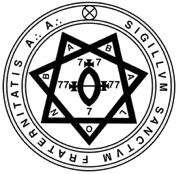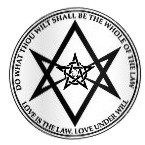|
|
» LIBER LIBRI «

LIBER CCVI - Book 206
Liber RV
vel
Spiritus
sub figurâ CCVI

A∴A∴ Publication in Class D
- _[1]
- _
- Let the Zelator observe the current of his breath.
- Let him investigate the following statements, and prepare a careful record of research.
- Certain actions induce the flow of the breath through the right nostril (Pingala); and, conversely, the flow of the breath through Pingala induces certain actions.
- Certain other actions induce the flow of the breath through the left nostril (Ida), and conversely.
- Yet a third class of actions induce the flow of the breath through both nostrils at once (Sushumna), and conversely.
- The degree of mental and physical activity is interdependent with the distance from the nostrils at which the breath can be felt by the back of the hand.
- First practice. --- Let him concentrate his mind upon the act of breathing, saying mentally, "The breath flows in", "the breath flows out", and record the results. [This practice may resolve itself into Mahasatipatthana (vide Liber XXV) or induce Samadhi. Whichever occurs should be followed up as the right Ingenium of the Zelator, or the advice of his Practicus, may determine.]
- Second practice. Pranayama. --- This is outlined in Liber E. Further, let the Zelator accomplished in those practices endeavour to master a cycle of 10, 20, 40 or even 16, 32, 64. But let this be done gradually and with due caution. And when he is steady and easy both in Asana and Pranayama, let him still further increase the period.
Thus let him investigate these statements which follow: ---
- If Pranayama be properly performed, the body will first of all become covered with sweat. This sweat is different in character from that customarily induced by exertion. If the Practitioner rub this sweat thoroughly into his body, he will greatly strengthen it.
- The tendency to perspiration will stoÿ as the practice is continued, and the body become automatically rigid.
Describe this rigidity with minute accuracy.
- The state of automatic rigidity will develop into a state characterised by violent spasmodic movements of which the Practitioner is unconscious, but of whose result he is aware. This result is that the body hops gently from place to place. After the first two or three occurrences of this experience, Asana is not lost. The body appears (on another theory) to have lost its weight almost completely and to be moved by an unknown force.
- As a development of this stage, the body rises into the air, and remains there for an appreciably long period, from a second to an hour or more.
Let him further investigate any mental results which may occur.
- Third Practice. --- In order both to economise his time and to develoÿ his powers, let the Zelator practise the deep full breathing which his preliminary exercises will have taught him during his walks. Let him repeat a sacred sentence (mantra) or let him count, in such a way that his footfall beats accurately with the rhythm thereof, as is done in dancing. Then let him practise Pranayama, at first without the Kumbhakam,[2] and paying no attention to the nostrils otherwise than to keep them clear. Let him begin by an indrawing of the breath for 4 paces, and a breathing out for 4 paces. Let him increase this gradually to 6.6, 8.8, 12.12, 16.16 and 24.24, or more if he be able. Next let him practise in the proper proportion 4.8, 6.12, 8.16, 12.24 and so on. Then if he choose, let him recommence the series, adding a gradually increasing period of Kumbhakam.[3]
- Fourth practice. --- Following on this third practice, let him quicken his mantra and his pace until the walk develops into a dance. This may also be practised with the ordinary waltz step, using a mantra in three-time, such as επελθον, επελθον, Αρτεμισ; or Iao, Iao Sabao; in such cases the practice may be combined with devotion to a particular deity: see Liber CLXXV. For the dance as such it is better to use a mantra of a non-committal character, such as Το ειναι, Το Καλον, Το Αγαδον,[4]or the like.
- Fifth practice. --- Let him practice mental concentration during the dance, and investigate the following experiments:
- The dance becomes independent of the will.
- Similar phenomena to those described in 5 (a), (b), (c), (d), occur.
- A note concerning the depth and fullness of the breathing. In all proper expiration the last possible portion of air should be expelled. In this the muscles of the throat, chest, ribs, and abdomen must be fully employed, and aided by the pressing of the upper arms into the flanks, and of the head into the thorax.
In all proper inspiration the last possible portion of air must be drawn into the lungs.
In all proper holding of the breath, the body must remain absolutely still.
Ten minutes of such practice is ample to induce profuse sweating in any place of a temperature of 17 Degree C or over.
The progress of the Zelator in acquiring a depth and fullness of breath should be tested by the respirometer.
The exercises should be carefully graduated to avoid overstrain and possible damage to the lungs.
This depth and fullness of breath should be kept as much as possible, even in the rapid exercises, with the exception of the sixth practice following.
- Sixth Practice. --- Let the Zelator breathe as shallowly and rapidly as possible. He should assume the attitude of his moment of greatest expiration, and breathe only with the muscles of his throat. He may also practice lengthening the period between each shallow breathing.
This may be combined, when acquired, with concentration on the Visuddhi cakkra, i.e. let him fix his mind unwaveringly upon a point in the spine opposite the larynx.)[5]
- Seventh practice.[6] --- Let the Zelator breathe as deeply and rapidly as possible.
- Eighth Practice.[6] --- Let the Zelator practise restraint of breathing in the following manner. At any stage of breathing let him suddenly hold the breath, enduring the need to breathe until it passes, returns, and passes again, and so on until consciousness is lost, either rising to Samadhi or similar supernormal condition, or falling into oblivion.
- Ninth practice. -- Let him practice the usual forms of Pranayama, but let Kumbhakam be used after instead of before expiration. Let him gradually increase the period of this Kumbhakam as in the case of the other.
- A note concerning the conditions of these experiments.
The conditions favourable are dry, bracing air, a warm climate, absence of wind, absence of noise, insects and all other disturbing influences,[7] a retired situation, simple food eaten in great moderation at the conclusion of the practices of morning and afternoon, and on no account before practising. Bodily health is almost essential, and should be most carefully guarded (See Liber CLXXXV, "Task of a Neophyte"). A diligent and tractable disciple, or the Practicus of the Zelator, should aid him in his work. Such a disciple should be noiseless, patient, vigilant, prompt, cheerful, of gentle manner and reverent to his master, intelligent to anticipate his wants, cleanly and gracious, not given to speech, devoted and unselfish. With all this he should be fierce and terrible to strangers and all hostile influences, determined and vigorous, increasingly vigilant, the guardian of the threshold.
It is not desirable that the Zelator should employ any other creature than a man, save in cases of necessity. Yet for some of these purposes a dog will serve, for others a woman. There are also others appointed to serve, but these are not for the Zelator.
- Tenth Practice. --- Let the Zelator experiment if he will with inhalations of oxygen, nitrous oxide, carbon dioxide, and other gases mixed in small proportion with his air during his practices. These experiments are to be conducted with caution in the presence of a medical man of experience, and they are only useful as facilitating a simulacrum of the results of the proper practices and thereby enheartening the Zelator.
- Eleventh practice. --- Let the Zelator at an time during the practices, especially during the periods of Kumbhakam, throw his will utterly towards his Holy Guardian Angel, directing his eyes inward and upward, and turning back his tongue as if to swallow it. (This latter operation is facilitated by severing the fraenum linguae, which, if done, should be done by a competent surgeon. We do not advise this or any similar method of cheating difficulties. This is, however, harmless.)[8]
In this manner the practice is to be raised from the physical to the spiritual-plane, even as the words Ruh, Ruach, Pneuma, Spiritus, Geist, Ghost, and indeed words of almost all languages, have been raised from their physical meanings of wind,[9] breath, or movement, to the spiritual plane.[10]
- Let the Zelator attach no credit to any statements that may have been made throughout the course of this instruction, and reflect that even the counsel which we have given as suitable to the average case may be entirely unsuitable to his own.
Footnotes
[1] WEH NOTE: The Liber omits sections 0 and 1 in earlier publication in EQUINOX I, 7 as well as here. There are signs that this version has been edited, notably changes were made in punctuation and capitalization. The editing appears to be defective, with some material omitted inadvertently. There is one original footnote, and the others are mine. There was also a photo page in the EQUINOX version.
[2] WEH NOTE: Equinox spells this "Kumbakham" in this spot only.
[3] WEH NOTE: Equinox spells this "Kumbhakham".
[4] WEH NOTE: The Equinox has this last word as: " γαθαν"
[5] WEH NOTE: In the Equinox this parenthetic paragraph is identified as an editorial comment.
[6] WEH NOTE: from this point, the text in the Equinox diverges from this text. There is an additional step: "11. "Seventh practice." Let the Zelator breathe as deeply and rapidly as possible." The step numbered here as "Seventh" is labeled "Eighth" in the Equinox.
[7] Note that in the early stages of concentration of the mind, such annoyances become negligible.
[8] WEH NOTE: Harmless, that is, if you don't mind the danger of choking to death in your sleep!
[9] WEH NOTE: The Equinox adds "air," to this list.
[10] RV is the old root meaning Yoni and hence Wheel (Fr. roue, Lat. rota, wheel) and the corresponding Semitic root means "to go". Similarly spirit is connected with "spiral". -- Ed.
Proof read and edited by Frater D.M.T. © Thelemagick.
[ » Primary Source: Liber RU vel Spiritus sub figurâ CCVI - English version « ]
- (source 1) (source 2) -

BACK TO LIBRARY

|
|